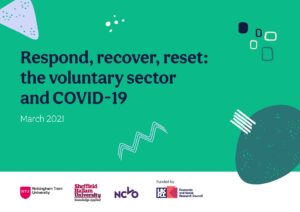April Pro Roundup: Thoughts on Volunteerism from Leadership Thought Leaders
Typically, we begin a Pro Roundup assignment with a subject that’s on top of “everyone’s mind” and research to see what volunteer leadership thought leaders have published on the subject.
This month, we decided to take the reverse path. With the question “What are industry thought leaders talking about?” we’re running down what topics organizations and influencers in volunteer leadership are discussing.
There are a number of people and organizations that contribute meaningfully to thought leadership in the volunteer management space, so it was a delight to see what folks were thinking and writing about.
The issues broke quite cleanly into three main subject areas:
1) the attraction and retention of dedicated volunteers;
2) tactical volunteer management tips;
3) and diversity, equity and inclusion in volunteerism.
So, follow along and discover what is being said by volunteer leadership thought leaders on these and a few other timely issues.
Leadership Thought Leaders: On Attracting & Retaining Volunteers
VolunteerHub, “How to Attract and Retain Volunteers in 2021”
VolunteerHub, an organization that supplies volunteer management solutions for nonprofits across the globe, has posted an article on “How to Attract and Retain Volunteers in 2021,” sharing eight key areas where they believe organizations should place their focus.
Among the expected advice:
- Organization and personal relationships are keys to recruiting and retaining volunteers.
- Encourage Emotional Investment
- Ask Personally
- Be Specific
- Match People with Opportunity
- Thank Them
There was one item that doesn’t appear as often, but is no less important:
“Share the Chain of Command – Let volunteers know who to contact if they have a question or need assistance. Then give them information to get in touch with that person. Also, give volunteers any emergency procedures that will be in place during the event.”
Another blog entry from their website – found in the Best Practices section – that may be of particular interest is “How to Lead Volunteers Towards Mission Attainment,” which includes tips such as:
- Form Relationships
- Restate the Objectives and Roles
- Lead Volunteers by Communicating
- Give Volunteers a Listening Ear
- Invest in Your Volunteer Program
Successful Nonprofits, “Groundbreaking Volunteer Management Ideas with Rob Jackson”
On a Successful Nonprofits “Putting the People back in Volunteerism” podcast episode, highlighted as one to “…shake up the norms surrounding who makes a great volunteer manager and how to retain volunteers”, Rob Jackson inquired, “…wouldn’t it be much better if you invested your effort in getting to know your volunteers well enough that you knew when they were thinking about leaving before they left?”
There are more thought-provoking takes on what it means to be a professional in the volunteer industry in the U.K. vs U.S. vs other cultures in the episode.
In searching for what SpinkTank, “The home of data-informed volunteer engagement”, had to offer, we found that one of their highest-ranking blog posts is one that is aging well. A post entitled “Farmers & Chefs” still ranks at number two on Erin Spink’s SpinkTank site.
In summarizing her experience at the 2017 National Summit on Volunteer Engagement Leadership, Erin Spink clearly garnered interest and continues to engage by sharing her belief that “…the relationship leaders of volunteers can and should have to volunteerism and volunteering is that of a chef to a farmer”.
This writing is a great reminder that volunteer leadership is well-likened to cultivation, and that the nurturing of a seed to harvest is metaphor for best practice recruitment and retention.
Wild Apricot, “New Volunteer Checklist: How to Onboard and Welcome New Volunteers”
Wild Apricot, “Powerful cloud software to help you automate and simplify membership tasks” shares their “New Volunteer Checklist: How to Onboard and Welcome New Volunteers” post. It includes items near and dear to any volunteer manager:
- Making new volunteers feel welcome
- Onboarding remote volunteers
- Orientation or onboarding that inspires and empowers
Leadership Thought Leaders: On Volunteer Management Tactical Tips
NCVO, “Respond, Recover, Reset Report,”
In searching NCVO (UK), I almost skipped over their most recent blog post, titled: “Funding Round Up March 2021.“ I thought it would be all columns and balance sheets but, then saw mention of “The latest Respond, Recover, Reset Report for March 2021” where they cited some interesting stats. This mention referred on to the full “Respond, Recover, Reset Report,” which has some compelling (if a little scary) information on how organizations are being affected by and responding to the pandemic.
Just goes to show, never skip the Roundup blog posts! They can lead you to powerful stuff.
Twenty Hats, “If leadership skills are so important, why bother with volunteer impact?”
Twenty Hats blog post from 2019 warrants mention in any compilation of tactical volunteer management advice, as it stresses the importance of measuring impact. It’s an explanation from Twenty Hats’ founder, Elisa Kosarin, about how her goals shifted from supporting general career growth of volunteer leaders to helping measure the impact of volunteers.
She contends that the ability to measure and communicate the value of a volunteer program inherently supports the career of a volunteer leader and that measurement skills are more easily taught and mastered than influential leadership. She says simply, “Understanding volunteer impact makes you more valuable.”
VQ Volunteer Strategies, “Planning for the New 3 Rs of Engagement: COVID-19 Recovery, Reopening, and Return”
Beth Steinhorn, President of VQ Volunteer Strategies offers guidance on recovery by emphasizing planning using the new 3 Rs in volunteer management. The original 3 Rs (recruitment, retention and recognition) are still vital to successful volunteer program.
In the post-COVID era, there are also added key factors, associated with high-performing organizations, needed to support an operation’s broader success. These are: leadership support; effective training; and planning.
Volunteer Plain Talk, “Volunteers and the Game of Complaints,”
Volunteer Plain Talk, is Meridian Swift’s straight-talking “blog for and about volunteer managers and the unique challenges we face.”
Her most recent blog entry: “Volunteers and the Game of Complaints,” is a no-holds-barred appeal to create professional boundaries as a volunteer manager and to keep an emotionally healthy workplace no matter who you are. It seems that Volunteer Plain Talk lives up to its own name with advice like: “Taking care of the volunteers is everyone’s business, not just the volunteer departments. Write a policy that says your employees will treat volunteers with respect and will not suck volunteers into conflicts.”
Interestingly, another relatively recent blog post by Meridan Swift: “Volunteer Programs: Incubators or Coops?“, brought us back to the notion of volunteer management as cultivation, as mentioned above.
Leadership Thought Leaders: On Diversity,
Equity & Inclusion
MAVA, “Advancing Racial Equity in Volunteerism“
MAVA, the Minnesota Association for Volunteer Administration, posted “Advancing Racial Equity in Volunteerism“, which discusses why volunteer teams often do not reflect the racial diversity of the communities they serve and how they are addressing the issue.
In it, they state: “Listening and centering the voices of BIPOC are essential steps we must take before we again move into action. This will allow us to expand our important work at a time when many people across the country are recognizing the historical and ongoing oppression experienced by BIPOC communities through systemic racism.”
ALIVE also announced on their homepage that the newest edition of Volunteer Administration: Professional Practice is available for purchase and that it features a new chapter on the role of diversity and inclusion in volunteer administration. This is the textbook that the Council for Certification in Volunteer Administration (CCVA) uses to guide the Certified in Volunteer Administration (CVA) exam.
Community-Centric Fundraising, “Does Your Board Need to Be More Diverse? Here’s How to Do It“
From Community-Centric Fundraising, their post entitled: “Does Your Board Need to Be More Diverse? Here’s How to Do It“, has a powerful list of dos, don’ts and things to think about when recruiting and welcoming a person of color onto your board. There are reminders to ask questions of yourself and others throughout the processes.
In addition to advising not to let your allyship be assumed, author Meenakshi Das, eloquently states, “Designing your board diversity with inclusion is going to be an ongoing journey every day, of creating deliberate space at the table, so no one has to carry their folding chairs to share their voice.”
Realized Worth, “Managing Change: Corporate Citizenship and Social Revolution”
Realized Worth discusses ways your organization can begin preparing to meet the needs of a changing world by planning for authentic impact at the center of everything you do in their article Managing Change: Corporate Citizenship and Social Revolution.
In it, they talk about the heightened focus right now on DEI and change calls for new way of measuring value in volunteerism that reflects more than just participation and event numbers. They circle us back to tips that support “…creating and maintaining a strong volunteer leadership network of intrinsically motivated employee volunteers” to aid the crossover between that work and social impact.
Engage Journal, “We Are Building Back Better, But For Whom?”
The Engage Journal’s take on how post-pandemic life might be different is shared in their discussion around the idea of “building back better”. In wondering whether leaders of volunteers are involved in future planning, they’re wanting to make sure all are represented in the establishment of priorities for going forward.
In re-building post-COVID policies and practices, they want us all to consider “…issues such as: social justice; equality, diversity and inclusion (EDI); a more environmentally conscious and sustainable way of living; and a more community-oriented approach to daily life that is less selfish and materialistic.”
Idealist, “How to Transition to a Social-Impact Career—Without Starting at Square One”
In a recent blog post, Idealist offers career transition advice for mid- to senior-level professionals who may be considering transferring their skills to a commensurate nonprofit sector role. That the advice is offered speaks to a rising tide of people who are wanting to work toward greater equality, a better environment, or just something beyond revenue generation.
“There’s a reason why you’re considering sector switching—for many people, it’s the desire to feel that you’re making a difference of some kind. You’ve probably already thought about which direction you want to go in, whether that’s an organization working towards community-based change, an NGO with global impact, or perhaps a specific health or environmental cause that you’re passionate about.”
More powerful than a blog post, VolunteerMatch is using National Volunteer Week to celebrate the work done by volunteers and combining that with bringing attention to Art as Activism.
This is a great example of living one’s values! There’s something for everyone. Events include:
- Discussing Art as Activism on Facebook LIVE on Wednesday, April 21 at 2pm EDT
- Beats for a Better World: National Volunteer Week 2021 Playlist
- Brushes + Buttons for a Better World: Activism as Beauty & Fashion
Points of Light, “Tackling Poverty and Inequality With HandsOn Northwest North Carolina and HandsOn Mexico“
In their recent updates section, Points of Light shares daily feel-good stories about the contributions and impact of volunteers. The most recent as of this writing was: ‘“Tackling Poverty and Inequality With HandsOn Northwest North Carolina and HandsOn Mexico”.
That story tells how HandsOn NWNC is focused on building racial equity in volunteering in particular, including having launched an ED Roundtable for organizations led by people of color.
Amy Lytle, executive director at HandsOn NWNC, describes how “Service has the power to unite people across differences and increase social capital; it builds empathy and can inform other forms of civic engagement, such as voting and public policy advocacy. Service can transform individual lives while also working to change systemic issues.”
Leadership Thought Leaders:
National Volunteer Week
No National Volunteer Week 2021 blog post would be complete without a few recognition ideas. Here’s what one volunteer leadership thought leader had to share:
Volunteer Canada, “20 ways to safely celebrate National Volunteer Week 2021”
In addition to 18 other ideas you could still possibly implement, here are two favorite suggestions from Volunteer Canada,’s post “20 ways to safely celebrate National Volunteer Week 2021″.
“Virtual book. Create a simple story with photos of volunteers and share on a virtual video call or make into a mini-movie. Creative writing a skill? Try writing a poem or spin-off of a known story i.e., Twas the night before National Volunteer Week…
Invite volunteers to submit a drawing, painting and combine into a mosaic for your website or an organizational wall hanging. Show the pride your organization has for volunteers.“
These are just a few of the things volunteer leadership thought leaders are talking about around the world.
What do you find most interesting? Or what did we leave out? Post it in the comments below.








